By David Michael
This paper addresses the key aspects of; preparation, deployment and support for RAN units deployed for Operation Damask between August 1990 and March 1991. During this period the Naval Support Command which had been established in 1987 with responsibility for policy and implementation of effective logistics operations was wholly responsible for the delivery of logistics support from the warehouse to units in theatre. This paper was first delivered to a Tri Service Logistics Commanders conference in September 1991. Its aim was to provide an overview of the dimension of the logistic effort involved in Operation Damask, the problems which arose and lessons learnt.
Supporting a Task Group 6,500 miles from Sydney is generally not a problem. The difference on this occasion was the compressed notice to deploy and unfamiliarly, with the Area of Operations particularly infrastructure in the local ports. On the latter point it was obvious that if support for the operation was to be successful, a reconnaissance was required. This was carried out in August/September 1990. The logistics plan was presented verbally on arrival of the Task Group in theatre on 3 September and approved by the Naval Support Commander on 18 September.
Generally, the Fleet programme gives a ship at least six months’ notice of deployment. HMA Ships Adelaide, Darwin and Success had four days. This included a weekend. At the time, Adelaide was exercising in the East Australia Area, Darwin was undergoing an engine change out at Garden Island and Success was enroute to ‘Melbourne for the weekend. First warning of the plan to deploy ships to the Gulf was received in Naval Support Command on Thursday 9th August.
Preliminary work to prepare the Command (particularly the supply system) for the activities which would be required in the event that Government decided to approve the deployment began immediately. Because of the sensitivity, preparations were to be limited only to those actions which would not be considered as pre-empting the Government decision.
There were particular difficulties to be overcome. For instance, AVCAT supplies were a problem. The only refinery in Australia that produces AVCAT, the shell refinery in Sydney, had closed down for maintenance.
The whole matter was further complicated by the fact that Success was not due back in Sydney until the Saturday afternoon. She had to initially top up at Chowder Bay with F76 and then undertake a tank clean to prepare her AVCAT tank. All this meant that any fuelling operation could not start till early on the Monday morning.
It was fortunate that there was a good stock of AVCAT at NAS Nowra. With the services of 5 Army and 10 Shell road tankers running a continuous shuttle service some. 40 deliveries over a 30 hour period allowed Success to be fully fuelled.
While this activity was underway there was a major evolution at Navy Supply Centre Zetland both at the executive level and in the warehouses.
Such actions involved obtaining computer listings of all the outstanding stores demands from the ships, ascertaining the availability of fuel, checking on stocks of special clothing, investigating the level of support available or aircraft, and determining the status of outstanding stores demands for the ships. In all some 7,700 line items of material were delivered to the ships during the period.
The platform coordination, and In-Service Design organisations were also involved in some major activities during the preparation period. A whole range of configuration changes to the FFG’s and Success were examined.
Modifications examined included the fitting of stabilised platforms for the Army RBS 70 Missile system as well as SATCOM and other communications fits.
The Naval Aviation Logistics Office was also very busy during this period evaluating a whole range of requirements for configuration changes to both aircraft and ascertaining the availability of special equipment (GPMG and FLIR[1]) both here and overseas. The Aircraft Logistics Office examined 13 major configuration changes and raised a number of high dollar value purchase orders. Modifications included arming the helicopters and enhancing personal equipment for the aircrew.
The ordnance manager and his organisation at the armament depots at Kingswood and Newington worked all over the weekend and their rostered day off to provide the ammunition requirements for the three ships.
Because of the tightness of the ammunition pipeline loaded ammunition barges had to be moored at Spectacle Island over the weekend. This was approved by the Minister granted in the form of a public risk waiver. Liaison was also required with Parramatta Council over the use of George Kendall reserve which comes within the quantity distance arcs for the Newington wharf. The council was very cooperative and closed the reserve to public use over the weekend.
The ammunitioning went ahead without any hitches and the ships sailed as planned.
It was fortunate however that the ships had required only relatively minor top ups of ammunition. Had there been a need for major ammunitioning’s these could not have been achieved in the timescale given the ammunitioning pipeline restrictions in place at the time.
Generally speaking, the same situation with respect to logistic’ readiness would have applied to any other units had they been selected. These three ships admittedly, had the advantage of having just returned from a RIMPAC Exercise[2].
An appreciation of the time frames involved may assist. The ships had seventeen days at sea to complete a work up and internal exercise programme before arriving in-theatre.
A logistic Directive was received from the Chief of Naval Staff on 23 August following issue of the ADF Logistic Concept on 22 August. It is of note that the allocation of Command of in theatre support to the Naval Support Commander was a break with doctrine but proved to be most effective particularly when communications circuits with the Task Group Commander became difficult and a ‘minimise’ ordered. Real time communication was paramount.
It also gave the Command a closer affinity with Maritime Headquarters and operational developments. This certainly improved Naval Support Command response times.
The resupply of stores was by commercial airfreight whilst that method remained reliable. RAAF C130 support was provided for dangerous, explosive and bulky items. RAAF support prior to January was provided punctually, and often at short notice on an as required basis.
A difficulty arose in early January as hostilities became imminent and the Command realised a regular military air freight service would-be the only solution while commercial services were disrupted. It took three weeks for the first weekly service to operate.
In the interim, advantage was taken of C130 aircraft used to deploy Clearance Diving Team 3. The reason for the delayed decision was due in part to a belief in HQ Australian Defence Forces and Air Headquarters that an adequate commercial service did exist. After critical cargo became stranded in London that appreciation changed.
On the other hand, RAAF assistance in supplementing the Logistic Support Element in theatre was first-rate. The addition of a sergeant’s skills in ground handling and loading made a large difference to the Logistics Support Element (LSE).
Support from RAAF and ARMY was substantial and critical to the success of the operation. A lot of hours were flown by RAAF during opposed transits and Work Ups as far as Diego Garcia.
Mention has already been made of the Air Lift Groups assistance with resupply. They flew a total of 22 missions in support of the operation. A round trip was six days.
Army made a substantial contribution through the timely provision of large quantities of Chemical Warfare (CW) protective clothing, medical stores and RBS 70 in Success and Westralia.
Single Service Logistic Management worked well but with some short comings. Most stores which were ‘in stock’ were obtained in minimal timeframes.
Forward Support Arrangements
Studies prior to deployment of the first group had indicated Dubai to be the best port to support forces in the area. However, RAN operations were initially limited to the Gulf of Oman (GOO) leaving Muscat as the best alternative. Although Muscat had limited infrastructure and severe customs and immigration restrictions, RANLO Muscat was established and the LSE was set up in the port of Mina Qaboos.
At the time and for some time later it was important for Australia to respect Omani sensitivities by not discussing their hospitality and support publicly even though it had been reported in the media.
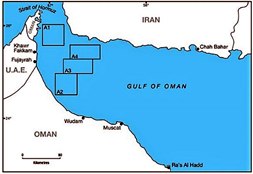 As previously mentioned, first deployment units operated only in the GOO. The FFG’s and Success made staggered port visits on a 3-week cycle with a regular weekly helicopter pick up at Seeb Airfield near Muscat. Mail and urgent stores were able to be delivered in reasonable time. The time between signal demand and receipt on board varied from 14 to 20 days ex Sydney.
As previously mentioned, first deployment units operated only in the GOO. The FFG’s and Success made staggered port visits on a 3-week cycle with a regular weekly helicopter pick up at Seeb Airfield near Muscat. Mail and urgent stores were able to be delivered in reasonable time. The time between signal demand and receipt on board varied from 14 to 20 days ex Sydney.
Whilst the FFG’s were deployed in the Northern and inner GOO, Success maintained a patrol line I well clear of attack, east of Muscat.
Success initially made forays into the inner GOO every 2-3 days to keep the FFG’s topped up. Subsequently, this became less frequent and Success combined fuelling runs with a re-supply visit to Fujairah, UAE where fresh fruit and vegetables were embarked at anchor for subsequent delivery to the FFG’s.
When the Task Group shifted operations into the Arabian Gulf on 16 December, a change in support operations was necessary.
LSE detachments were set up in Dubai (LEUT plus 1 Senior Sailor) and in Bahiain (1 Senior Sailor). The logistic concept of operations remained the same except that Success and later Westralia shuttled from Dubai. Customs delays in Bahrain and Dubai were significantly less than in Oman but the benefit was not achieved until stores began to be air freighted directly to those ports. Sydney in particular was able to clear materiel from Bahrain very quickly due to blanket diplomatic clearance for helicopter operations. At sea, Task Group logistic support was more formally integrated into the Carrier Battle Group coming under USN tactical control.
As circumstances changed and the frequency and location of port visits varied the RANLO was able to vary his arrangements for forward supply. Numerous options were available largely as a consequence of close and regular liaison with the local Commanders of other nations military units in the area co-operation was extremely valuable.
During operations in the GOO programming flexibility gave the Commander of the Task Group (CTG) sufficient options to resupply Task Group units at sea using a mix of embarked aircraft, as the volume and weight of cargo dictated. However, once tactical control arrangements changed and the support ship alone was available less frequent opportunities and greater ranges from the LSE made the Squirrel helicopter less than adequate for the task.
Success did not have a Seahawk helicopter. Westralia had no organic aircraft.
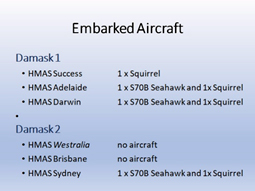 The notable difference in capability between Success and Westralia had a significant impact on support. Westralia’s rigs and manning concept imposed limitations on the degree of logistic independence of the Task Group. In particular her lack of ability to transfer bulk stores at sea made fresh and frozen provisions support more difficult. The operational tempo required air defence capable ships to maintain extended periods at sea. Both Brisbane and Sydney spent 47 consecutive days at sea immediately prior to and during the war. Without access to port visits for replenishment the Task Group obtained fresh fruit and vegetable support from the USN. USN logistics ships operated a regular shuttle service to assigned units on a two-week cycle.
The notable difference in capability between Success and Westralia had a significant impact on support. Westralia’s rigs and manning concept imposed limitations on the degree of logistic independence of the Task Group. In particular her lack of ability to transfer bulk stores at sea made fresh and frozen provisions support more difficult. The operational tempo required air defence capable ships to maintain extended periods at sea. Both Brisbane and Sydney spent 47 consecutive days at sea immediately prior to and during the war. Without access to port visits for replenishment the Task Group obtained fresh fruit and vegetable support from the USN. USN logistics ships operated a regular shuttle service to assigned units on a two-week cycle.
Westralia’s visits to Dubai were generally arranged to meet the weekly C 130. She then ferried mail and urgent items to RAN ships while meeting other Task Force requirements on an availability basis.
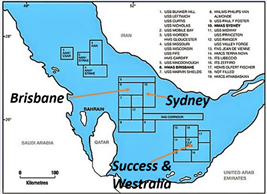 The absence of local Australian Government representation increased the difficulties of working in an unfamiliar environment and meant RANLO undertook a lot of representational and liaison tasks.
The absence of local Australian Government representation increased the difficulties of working in an unfamiliar environment and meant RANLO undertook a lot of representational and liaison tasks.
The range and depth of activity undertaken by the Logistics Support Element (LSE) included;
Logistics Support Element and RAN Liaison Officer
Locations
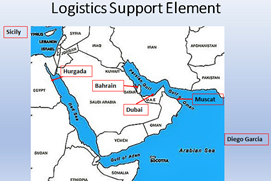 At various phases of the war LSE detachments were moved to optimise logistics support to the deployed ships. The locations included;
At various phases of the war LSE detachments were moved to optimise logistics support to the deployed ships. The locations included;
- Muscat, Oman
- Bahrain
- Dubai, UAE
- Diego Garcia, Indian Ocean
- Hurghada, Egypt
- Sigonella, Sicily
 The range and depth of activity undertaken by the Logistics Support Element (LSE) was broad and included, stores mail, personnel administration, arranging contracts and services for ship visits, coordinating arrangements for visitors, resupplying Clearance Divers in Kuwait.
The range and depth of activity undertaken by the Logistics Support Element (LSE) was broad and included, stores mail, personnel administration, arranging contracts and services for ship visits, coordinating arrangements for visitors, resupplying Clearance Divers in Kuwait.
LSE personnel worked long hours seven days a week. Political sensitivities at home about the size of the Australian presence made it difficult to increase LSE strength on the ground particularly as the number of locations increased.
After the departure of the second RAN Task Group on 22 March, the complement of the LSE was progressively run down to one officer and three senior sailors and on 24 April the Team relocated to Bahrain.
In the period after the war the LSE provided direct support to the RAN Clearance Diving Team in Kuwait.
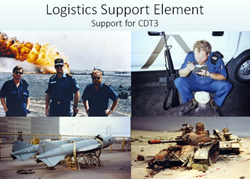 This was done by road from Bahrain and by use of allied intra-theatre air transport resources. The LSE also coordinated the return to Australia of the CDT3 and a large quantity of captured Iraqi equipment.The RANLO and LSE remained in place in Bahrain providing support to other Defence personnel in the region and Australian personnel assigned to Operation BLAZER[3].
This was done by road from Bahrain and by use of allied intra-theatre air transport resources. The LSE also coordinated the return to Australia of the CDT3 and a large quantity of captured Iraqi equipment.The RANLO and LSE remained in place in Bahrain providing support to other Defence personnel in the region and Australian personnel assigned to Operation BLAZER[3].
Numerous lessons for Naval Support Command came out of Operation DAMASK. Most were of an internal nature but some affect other authorities. Key lessons learnt included;
- The success of organisational changes in recent years to make Support Command an integrated Logistic organisation. This made control of the many and varied activities much easier.
- At the time of deployment there were no standard orders, or guidance for the establishment, and deployment of a Forward Support Base overseas.
- A reconnaissance was a prerequisite to drafting a Logistic Plan. The plan had to remain flexible.
- Resupply of guided weapons and conventional ammunition in significant quantities was not tested. Without Success in the area, or USN support, the RAN would have had to seek alternatives.
- Reliance on a sole supplier for AVCAT has the potential to cause major difficulties.
- Establishing reliable secure communications was an initial difficulty which frustrated LSE operations.
- There is a requirement for contingency instructions regarding strategic air support of Naval Support Command when commercial air services are not an option.
- Fast tracking of work associated with enhancements to ships and aircraft-is-possible-but-not without intensive management.
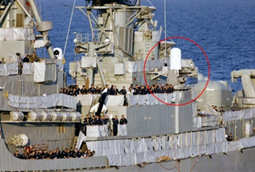
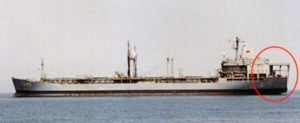
Timeline Operation Damask 1 and 2
| Date | Event |
| 6 Aug 90 | UN Resolution 661 placed economic sanctions on Iraq. |
| 9 Aug 90 | HQ ADF warning order issued |
| 10 Aug 90 | Prime Minister Hawke affirmed Australia’s commitment to send RAN warships to the Persian Gulf. |
| 13 Aug 90 | HMAS Adelaide and HMAS Darwin sailed from Sydney |
| 14 Aug 90 | HMAS Success sailed from Sydney |
| 25 Aug 90 | UN Resolution 665 authorizing naval blockade. |
| 27 Aug 90 | RAN Reconnaissance Team arrive AO |
| 30 Aug 90 | Logistic Support Element established Muscat. |
| 3 Sep 90 | First Task Group arrived in AO. |
| 12 Nov 90 | HMAS Brisbane & Sydney sailed from Sydney for the AO under the auspices of Operation DAMASK II. |
| 29 Nov 90 | UN Resolution 678, giving Iraq until 15 January 1991 to withdraw from Kuwait. |
| 3 Dec 90 | PM Hawke announced RAN units could pass through the Strait of Hormuz to the Arabian Gulf. |
| 3 Dec 90. | HMAS Brisbane and Sydney arrived in the AO. |
| 2 Jan 91 | HMAS Westralia sailed from HMAS Stirling for the AO. |
| 17 Jan 91 | Operation Desert Storm bombing campaign launched. |
| 25 Jan 91 | HMAS Success departed AO arriving in Sydney on 8 March. |
| 26 Jan 91 | HMAS Westralia arrived in AO. |
| 24 Feb 91 | Operation Desert Storm ground assault launched. |
| 28 Feb 91 | Coalition’s ground advance ended with a ceasefire. |
| 26 Mar 91 | HMAS Brisbane and Sydney departed the AO for return to Sydney arriving 22 April. |
[1] GPMG, General Purpose Machine Gun. FLIR, Forward Looking Infra Red
[2] RIMPAC Exercises are multinational ‘Rim of Pacific Exercise’ conducted by the USN in the Hawaiian area for maritime nations bordering the Pacific Ocean.
[3] The United Nations sponsored Operation Blazer was established in April 1991 by Resolution 687 to impose a peace agreement and disarmament provisions on Iraq. It also established a UN Special Commission, UNSCOM tasked with locating and supervising the destruction of Iraqi nuclear, chemical and biological weapons of mass destruction capabilities.




